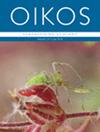Linking intrinsic scales of ecological processes to characteristic scales of biodiversity and functioning patterns
IF 3
2区 环境科学与生态学
Q2 ECOLOGY
引用次数: 0
Abstract
Ecology is a science of scale, which guides our description of both ecological processes and patterns, but we lack a systematic understanding of how process scale and pattern scale are connected. Recent calls for synthesis between population ecology, community ecology, and ecosystem ecology motivate the integration of phenomena at multiple organizational levels. Furthermore, many studies leave out the scaling of a critical process: species interactions, which may be non-local through movement or foraging and must be distinguished from dispersal scales. Here, we use simulations to explore the consequences of three different process scales (species interactions, dispersal, and the environment) on emergent patterns of biodiversity, ecosystem functioning, and their relationship, in a spatially-explicit landscape and stable equilibrium setting. A major result of our study is that the spatial scales of dispersal and species interactions have opposite effects: a larger dispersal scale homogenizes spatial biomass patterns, while a larger interaction scale amplifies their heterogeneity. Interestingly, the specific scale at which dispersal and interaction scales begin to influence landscape patterns depends on the scale of environmental heterogeneity – in other words, the scale of one process allows important scales to emerge in other processes. This interplay between process scales, i.e. a situation where no single process dominates, can only occur when the environment is heterogeneous and the scale of dispersal small. Finally, contrary to our expectations, we observe that the spatial scale of ecological processes is more clearly reflected in landscape patterns (i.e. distribution of local outcomes) than in global patterns such as species–area relationships (SARs) or large-scale biodiversity–functioning relationships. Overall we conclude that long-range interactions often act differently and even in opposite ways to dispersal, and that the landscape patterns that emerge from the interplay of long-ranged interactions, dispersal and environmental heterogeneity are not well captured by often-used metrics like the SAR.将生态过程的内在尺度与生物多样性和功能模式的特征尺度联系起来
生态学是一门尺度科学,它指导着我们对生态过程和模式的描述,但我们对过程尺度和模式尺度之间的联系缺乏系统的了解。最近,人们呼吁将种群生态学、群落生态学和生态系统生态学综合起来,这促使我们整合多个组织层面的现象。此外,许多研究忽略了一个关键过程的尺度:物种相互作用,这种相互作用可能是通过运动或觅食实现的非局部性,必须与扩散尺度区分开来。在此,我们使用模拟方法,在空间明确的景观和稳定平衡环境中,探讨了三种不同过程尺度(物种相互作用、扩散和环境)对生物多样性、生态系统功能及其关系的新模式的影响。我们研究的一个主要结果是,物种扩散和物种相互作用的空间尺度具有相反的效果:较大的扩散尺度会使空间生物量模式趋于均匀,而较大的相互作用尺度则会放大其异质性。有趣的是,分散和相互作用尺度开始影响景观模式的具体尺度取决于环境异质性的尺度--换句话说,一个过程的尺度允许其他过程出现重要尺度。这种过程尺度之间的相互作用,即没有单一过程占主导地位的情况,只有在环境异质性高、扩散尺度小的情况下才会出现。最后,与我们的预期相反,我们观察到生态过程的空间尺度在景观模式(即局部结果的分布)中比在物种-区域关系(SARs)或大规模生物多样性-功能关系等全球模式中得到了更清晰的反映。总之,我们得出的结论是,远距离相互作用的作用方式往往不同于扩散,甚至与扩散的作用方式相反,而且远距离相互作用、扩散和环境异质性相互作用所产生的景观模式并不能被经常使用的指标(如 SAR)很好地捕捉。
本文章由计算机程序翻译,如有差异,请以英文原文为准。
求助全文
约1分钟内获得全文
求助全文
来源期刊

Oikos
环境科学-生态学
CiteScore
6.20
自引率
5.90%
发文量
152
审稿时长
6-12 weeks
期刊介绍:
Oikos publishes original and innovative research on all aspects of ecology, defined as organism-environment interactions at various spatiotemporal scales, so including macroecology and evolutionary ecology. Emphasis is on theoretical and empirical work aimed at generalization and synthesis across taxa, systems and ecological disciplines. Papers can contribute to new developments in ecology by reporting novel theory or critical empirical results, and "synthesis" can include developing new theory, tests of general hypotheses, or bringing together established or emerging areas of ecology. Confirming or extending the established literature, by for example showing results that are novel for a new taxon, or purely applied research, is given low priority.
 求助内容:
求助内容: 应助结果提醒方式:
应助结果提醒方式:


